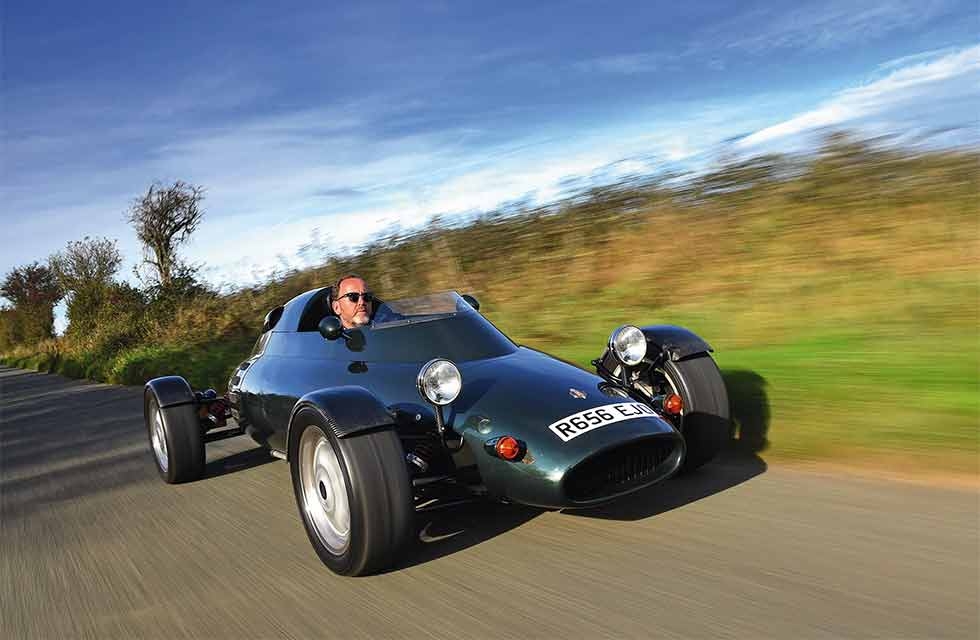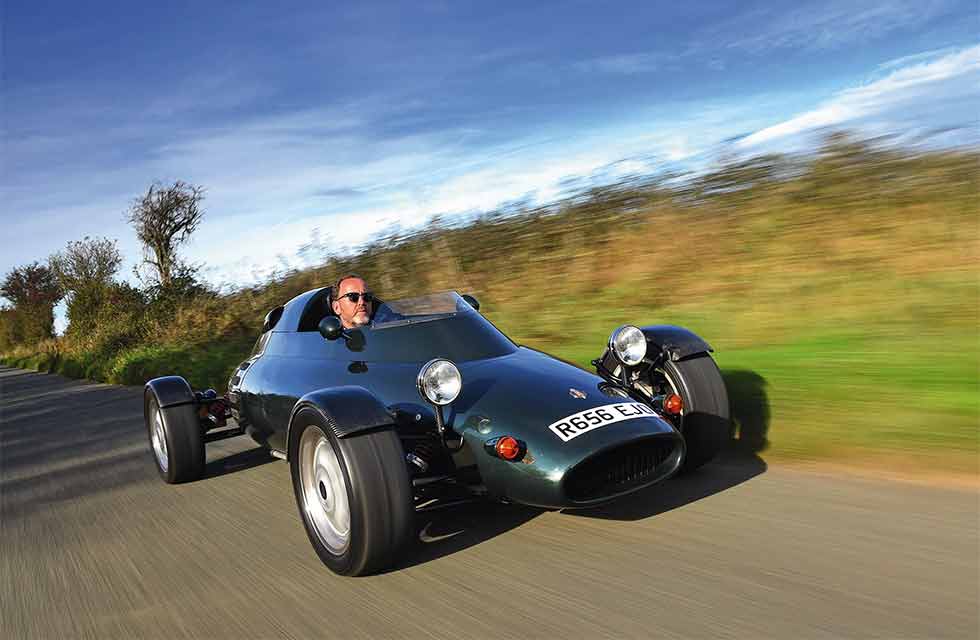
From Murray the man to his purest road car, the sensational LCC Rocket, which proves that less is more when it comes to real driving thrills. Words James Page. Photography Will Williams.
SUPERSONIC! GUIDED MISSILE James Page gets behind the wheel of the beguilingly brilliant LCC Rocket
Never has a car’s name been so accurate. Small, nimble and shatteringly quick, the Light Car Company Rocket is as close as you’ll get to driving a single-seater on the public road. With the sensation of speed heightened by sitting so low down and open to the elements, there can be few more entertaining ways to blat across the Cotswolds on an autumn day.

Never mind that the 1000cc Yamaha motorcycle engine is producing less than 150bhp. The car that it’s propelling weighs only 370kg, giving it a power-to-weight ratio roughly equivalent to that of a Ferrari F40. And it’s the way in which it delivers its power that’s so addictive – not often do you drive a car with an 11,500rpm redline.
Below 6000rpm, it’s pretty fast. Above that, you’re into another realm of noise and acceleration, trying to keep up by banging through the gears in the sequential ’box. On smaller B-roads, even chickening out at 8500rpm – by which point every fibre of your being is telling you to change up – will result in you making seriously rapid progress. This must be what it feels like to ride a superbike, minus the fear of falling off.
Then there’s the handling. With so little heft, the diminutive Rocket changes direction without hesitation via steering that is as beautifully weighted and undiluted as it comes. Even the ride is pretty good, and nowhere near as harsh as the car’s wild looks would suggest. The central seating position gives you a great view across the front wheels, and also means that you’re over the roll centre, which further enhances the feeling of stability.
There are foibles, of course. The five-speed gearbox features high and low ratios, giving you 10 speeds to play with, but apart from a light that comes on when you’re in neutral, there’s nothing to indicate which gear you’re in. Glancing at the lever won’t help because the sequential shift means it’s always in the same position. You have to keep count unless you want to arrive at a junction and spend a minute trying to find first again.
It’s sensitive to road camber, too, which requires a firm hand as the speed builds. And with minimal flywheel effect, the engine blips to 3000 or 4000rpm as soon as you go near the throttle. Pulling away with any sense of decorum is therefore an acquired art. Frankly, though, who cares when you’re having this much fun?
The Rocket was the brainchild of racing driver Chris Craft and design genius Gordon Murray. After a long and hugely successful career in Grand Prix racing, by the end of the 1980s Murray had started to shift his attention to the McLaren F1 road-car project.
“I’d met Chris in late 1971,” he recalls, “when I was designing the Duckhams-Ford 3-litre Le Mans prototype for Alain de Cadenet. Ever since he drove the Duckhams, Chris was banging on about me doing a road car – every year or, if not, every second year, but I was just too busy in Formula One.
“Then I said to him, ‘I’m stopping Formula One in 1989 and setting up a new car company for McLaren in 1990. If I’m going to do a car, it has to be in that break.’ That was the plan, but it took much longer because I literally drew every single part of the car. I thought I could bang it out in three or four months, but it actually took about a year in the end.”
Throughout his design career, Murray has been obsessive about weight. It didn’t take long for him and Craft to decide what they wanted to do: “My main goal in designing the Rocket was to ‘out-Chapman’ Colin Chapman. The Lotus Seven was still the lightest road car that you could buy. I said to Chris that, if we’re going to do this, it has to be something I want to do, too. When I first started talking about a single-seater and the retro styling, he loves that sort of stuff so we were pretty much in tune.
“I remember sitting with him and saying, ‘If we use standard Ford components and a standard engine and everything else, we’ll end up at the same weight as a Seven.’ So it was a case of either doing it properly or not at all.”
In terms of a lightweight powerplant, the solution was to use that manic Yamaha FZR1000 ‘four’. It wasn’t a new thought, of course – everything from Morgans to Berkeleys had employed motorcycle units in years gone by – but not for a long time had anyone tried it. And modern ’bike engines were very different from those of decades past.
“It had lots of issues,” says Murray, “not least of which was the massively high revs. Then it had to have a speedo drive, because the speedo drive was a cable in those days. Plus reverse gear, a diff, how to get the drive out of the motorbike gearbox into the diff – all that stuff.”
Murray turned to transmission guru Pete Weismann for help. Weismann was an old friend of his, going back to the Brabham days: “Pete came up with a fantastically compact transmission that really solved all those problems.” Weismann then incorporated a two-speed final drive into the same package, following those concerns that the engine’s high-revving nature would become tiresome. The result is that, instead of screaming its head off at 80mph, the Rocket is doing an entirely manageable 4000rpm in its higher ratio.
Murray designed the outer casing for the gearbox because, in a further bid to save weight, he wanted to do away with any extra framework for the suspension, and instead mount everything directly to the engine and gearbox: “Normally, you’d run the frame past the engine and pick up all the wishbones and the springs, but the Rocket is like a Formula One car in that the engine and gearbox are structural. They’re loaded in torsion, as well as fore and aft during acceleration and braking. They’re bolted directly to the chassis, so there’s no chassis beyond the rear bulkhead behind the driver. It saves eight to 10 kilos, I reckon.”
As for the chassis itself, Murray considered a number of possible solutions: “I looked at everything. I looked at a carbon tub, an aluminium tub – but funnily enough, for that layout, I reckoned a spaceframe would be just as light. And certainly stiff enough for the load inputs that we were going to get from skinny tyres. The chassis came out at 21kg, and I doubt if a carbon monocoque would have been any lighter.” Although Craft gave Murray pretty much a free hand in terms of the design, the tandem seating arrangement came about following his insistence that a passenger should also be able to enjoy the ride.
“It was always going to have a central seat,” remembers Murray, “but Chris was adamant – and he was right – that it should be a two-seater so that you could take someone with you. I was trying to hit a 350kg weight target, which is why I wanted it to be a single-seater.”
The arrangement works well, although the passenger has to assume a slightly undignified position, with their legs running either side of the driver. There are grabhandles should you feel the need to hold tight, yet there’s a surprising amount of room. Murray is 6ft 4in, but he nonetheless drove his Rocket down to the south of France with his equally tall son, Dylan, cocooned behind him.
In fact, there’s a link between Dylan Murray and our featured Rocket, which was the first one built and was retained by the firm as a development car. By 1999, it had been given the chassis number 034, and Dylan and Luke Craft – Chris’ son – used it to win the ‘Spirit of the Gumball’ award on the Gumball 3000. Eventually, Chris Sherington persuaded them to part with it, and shortly afterwards it passed to Tim Whittaker, who’s now owned it for a decade.
“Before [Sherington] took delivery, he asked them to take it all apart and fettle everything,” explains Whittaker. “He wanted the front side-light pods removed – all the other Rockets had four pods – then the headlights drilled out and the sidelights put into the headlights. He wanted the headrest put on, and he didn’t want a single zip-tie on it – Ducati makes some really nice things for holding wiring harnesses. So, when you look around it, there are all these different bits and pieces.
“When he took delivery, his circumstances changed and he decided to sell it. I saw the advert – in Classic & Sports Car, actually – and it was only a line in the back. There wasn’t even a picture. It just said: ‘Light Car Company Rocket for sale.’ I went straight down there, didn’t haggle, and just bought the car.”
Whittaker recalled seeing the Rocket featured on Top Gear when it was new, and his background in automotive engineering gave him an appreciation for Murray’s design: “I love looking at things and seeing how they’re made. The whole concept of the thing appealed to me. It just seemed so clever and so simple. It stuck in my head. I’d only ever seen one at Beaulieu, though – you don’t see them around. I always thought, if one comes up…
“I sold the kitchen sink, got rid of a Laverda ’bike, sold everything I could to get it, and I’ve had it ever since. It’s been nothing but fun.”
The Light Car Company still exists and is now run by Chris Holley, who looks after Whittaker’s Rocket. Such is the car’s lack of weight that it puts very little load through its components. Whittaker reports that Holley has never changed the brake pads on one, and the tyres will go hard before they wear out.
“The big thing is the gearbox,” he says of using the Rocket on a semi-regular basis. “You need to understand how to get the most from the transmission to suit the speed you’re doing. For longer runs, it’s better in the high ratio but the lower gears – so, second or third. You tend to find that you go faster and faster, and have to slow yourself down.
“When I first bought it, I didn’t realise there was a high and low ratio, so I pulled away in high ratio! I thought, ‘God, this is a real pig.’ Then I realised…”
One thing he’s certainly never tried is to match 034’s other claim to fame. Shortly after the Gumball, Car magazine decided to see how fast it would go backwards – the reason being that, once you’ve selected reverse, you have all 10 gears available to you.
“The problem is,” says Whittaker with a smile, “it’s got a little bit of toe-in, so when you’re going backwards, it’s toeing out. They stopped after the fourth attempt, when they’d spun again, but they’d got it up to 104mph.”
In the end, only 45 chassis were made during the initial production run, although Craft did attempt a revival in 2007 with an updated Rocket. An asking price of £38,800 in 1992 didn’t help in terms of shifting cars.
“It was way ahead of its time as an expensive track toy,” reflects Murray. “They didn’t exist in those days. Because everything was bespoke, the sales price was huge.”
Beatles legend George Harrison had one, and took it – unannounced – to the first Goodwood Festival of Speed. Story has it that Lord March (as he was then) was horrified when he saw it parked near the stables and tried to get it moved. When he realised who it belonged to, and what it was, he invited Harrison to drive it up the hill. Fellow owners included Bill Gates, Mark Knopfler and Jay Leno, and these days its profile is probably higher than ever. Its inclusion in the Gran Turismo series of video games means that kids know what it is, even if their parents don’t.
Murray describes it as being a “mini McLaren F1” in terms of its focus, its purity of design and its adherence to light weight and bespoke components. It could be argued, in fact, that the Rocket is an even better expression of his design principles than the headline-grabbing F1. It’s as distilled as road cars get, and surely no-one has ever done more with less.
“If ever I want to teach somebody about light weight and low inertia,” he concludes, “I say get in a Rocket and drive it for half an hour. It’s better than 1000 words.”
Thanks to Angus MacCurrach, The Classic Motor Hub (01242 384092; classicmotorhub.com)
TECHNICAL DATA FILE SPECIFICATIONS 1992 LCC Rocket
Sold/number built 1992-1998/34 (complete cars, from 45 chassis)
Construction multi-tubular steel spaceframe with stressed aluminium panels, glassfibre bodywork, carbonfibre cycle wings
Engine all-alloy, dohc, 20-valve 1002cc ‘four’, four Mikuni carburettors
Max power 143bhp @ 10,500rpm / DIN nett
Max torque 77lb ft @ 8500rpm / DIN nett
Transmission five-speed sequential manual, dog engagement, twin-speed rear axle, LSD Suspension double wishbones all round, coilover dampers
Steering rack and pinion, 2.4 turns lock-to-lock
Brakes 11in (279mm) Brembo ventilated and cross-drilled front, 10 ½ in (267mm) cross-drilled rear discs, aluminium calipers
Length lift 6 ½ in (3518mm)
Width 5ft 3in (1600mm)
Height 3ft (914mm)
Wheelbase 7ft 11 ¼ in (2413mm)
Weight 815lb (370kg)
0-60mph 4.4 secs
Top speed 145mph
Mpg 35
Price new £38,800
Price now £75,000-100,000
Clockwise from top: colour is the correct BRM green; unpainted steering-wheel logo is unique to this car; colourful bonnet badge; headlamps swing down out of the way when not in use, and a removable panel covers the passenger area.
“The Rocket is like a Formula One car in that the engine and gearbox are structural – it saves eight to 10 kilos I reckon”






